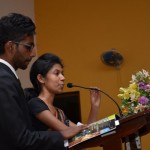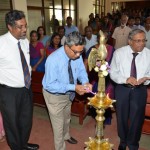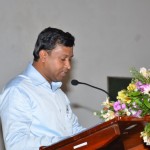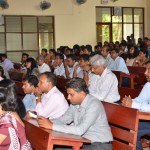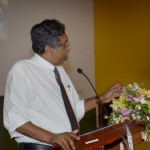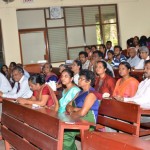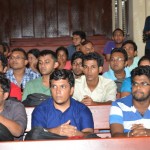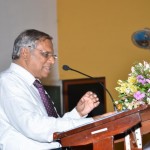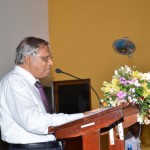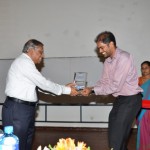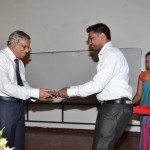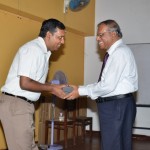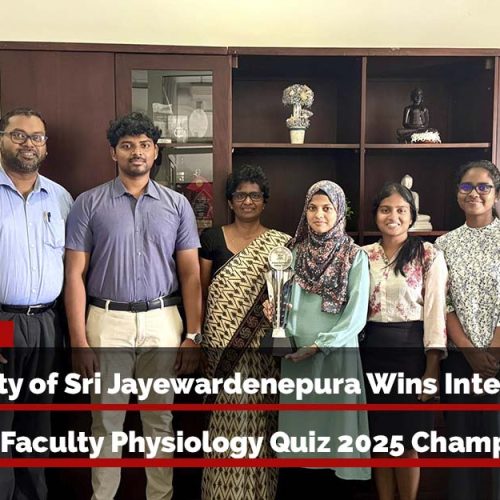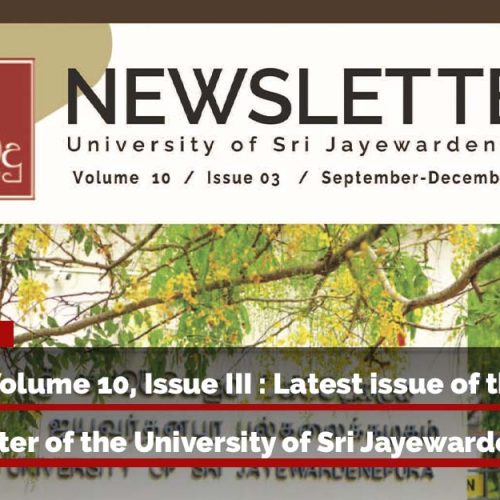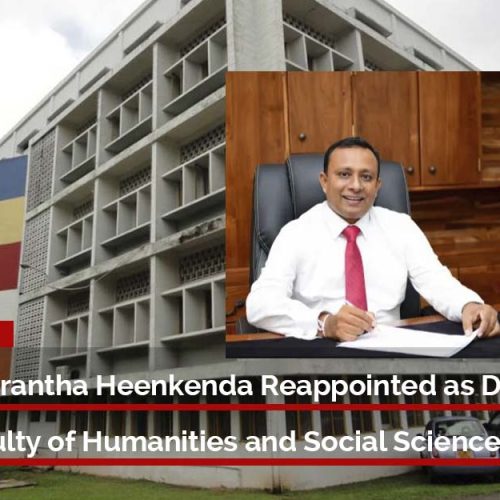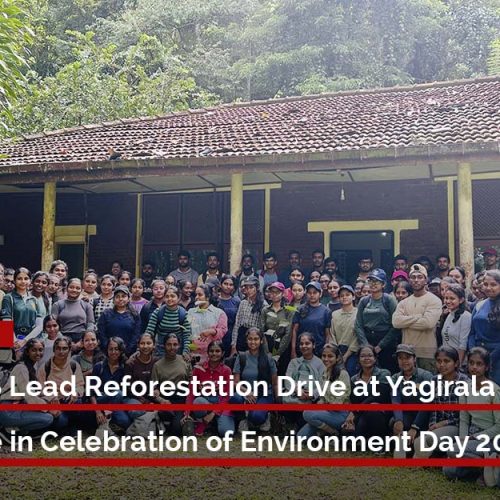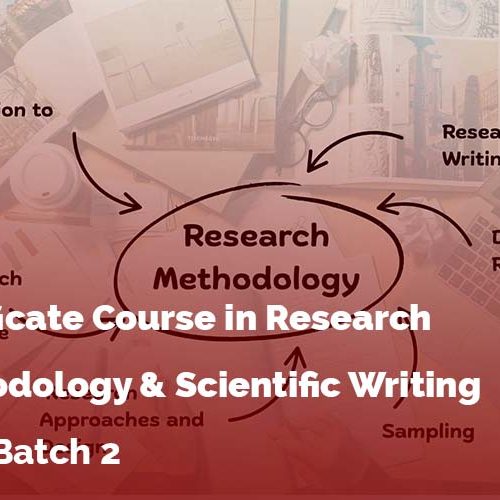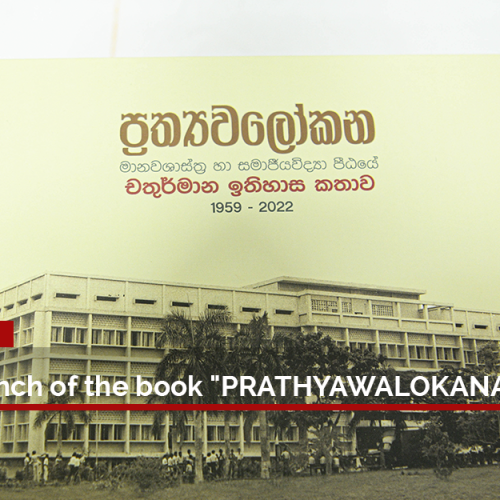Valedictory Lecture delivered by Prof. Dhammika A. Tantrigoda, Chair and Senior Professor of Physics on 19th March 2015 at Science Auditorium
First of all I would like to thank the Physics Society for inviting me to deliver a valedictory lecture on the eve of my retirement from the position of Chair and Senior Professor of Physics of the University of Sri Jayewardenepura. In leading universities of the world, it is a well known tradition to organize an inaugural lecture to mark the appointment of a new Professor and also to organize a valedictory lecture to mark his or her retirement. However, this tradition is rarely practiced in Sri Lanka. An inaugural lecture serves the purpose of introducing the vision, ideology, and the research and academic orientation of a newly appointed Professor, to the academic community. On the other hand, a valedictory lecture is delivered by a retiring Professor to bid farewell to the academic community and more importantly to celebrate his or her contribution over the years to the discipline, university and the community at large. I am indeed much obliged to the Physics society and its Senior Treasurer Dr.N.G.S. Shantha for making arrangements for this valedictory lecture which I deliver as the last formal academic activity that I perform as the Chair and Senior Professor of Physics at the University of Sri Jayewardenepura.
Read or Download the book:
The topic that I have chosen for my valedictory lecture is “Creativity, Concepts and Development”. In my lecture I shall try to illustrate how the very special quality called “creativity” possessed only by human beings, has been used to give rise to a process called concept building , and how the concept so built have been used in the development process.
Philosophy has a stream of knowledge that has a long history which goes back to several millennia. Different philosophies have originated in different parts of the world. I would like to draw your special attention to ancient Greek philosophy, especially in view of its close relationship to modern science. Ancient Greek philosophy began around 6th century BC and was dominated by three great philosophers Socrates, Plato and Aristotle. Ancient Greek Philosophy covers a wide variety of disciplines such as Ethics, Political Philosophy, Metaphysics, Epistemology and Mathematics. In fact, it is acknowledged that the present day knowledge of most of the branches of modern science and other knowledge domains is based on fundamental ideas that have been expounded by the ancient Greek philosophers.
Undoubtedly, the body of knowledge created by the ancient Greek philosophers and other philosophers- Arab, Indian and Chinese- formed an important stream of knowledge. While noting the importance of this philosophical stream we need to realize that this was not the only stream of knowledge that existed during that time. There was another stream of knowledge that is much older than philosophy and can be considered as equally important, if not more. This was the knowledge of ordinary people- knowledge of the farmers who worked the agricultural fields, knowledge of the carpenters and masons who constructed buildings and edifices and knowledge of slaves who laboured to build the pyramids. In short, this was the knowledge of artisans from the world of work. These two streams of knowledge existed side by side as two independent entities for a long period of time, until two important intellectuals of the 16th century focussed their attention to this dichotomy. They were Francis Bacon and Galileo Galilei. In my lecture I would confine my remarks only Galileo’s contribution even though the contribution of Francis Bacon is equally important.
Galileo Galilei was born on 18th February 1564 in Pisa. In spite of Galileo’s interest in mathematics and mechanical innovations from his young days, his father expected him to pursue a career in medicine. He joined the University of Pisa and studied medicine and the philosophy of Aristotle. Having realized that Galileo has no interest in medicine and his strength is in mathematics his father allowed him to study mathematics. He studied mathematics at Florence and soon became a renowned mathematician of that era and was successful in securing a position as the Professor of Mathematics at the University of Pisa in 1589. Later he was appointed to the prestigious position of Chair of Mathematics at the University of Padua.
Galileo was never in total agreement with Aristotelian philosophy. In fact, very often he has been highly critical of certain aspects the Aristotelian philosophy. He openly disagreed with the Aristotle’s geocentric theory of the universe and favoured the Copernican system of the heliocentric universe. Furthermore, he was highly skeptical of the view professed by the Greek philosophers of the time that the behaviour of nature can be understood through rational arguments alone. His contribution to knowledge has been documented in two great books authored by him. The first was the “Dialogue Concerning the Two Chief World Systems” in which he challenged the Aristotelian cosmology. The second was “Dialogue Concerning Two New Sciences” which is widely considered as the cornerstone of modern physics. This book which has been written in the form of a dialogue probably narrates the experience that Galileo gained through his interaction with the world of work. Through this book he has made a highly successful attempt to present a mechanical “model” of the universe. He tried to explain many phenomena that we are familiar with by using the concept of “force”. It is true that this concept was first introduced by Aristotle. However, it was Galileo who introduced the concept to explain a wide spectrum of phenomena. He successfully explained the equilibrium of structures in terms of the concept of force. It is important to realize that force is not something that exists in reality. It is only a concept which has been created to explain certain ‘class of situations’.
The concept of force was further developed by the well known English physicist and mathematician Sir Isaac Newton. He formulated three laws which are known as Newton’s laws of motion through which he made the concept of force more real. Through his first law he defined the concept of force and through the second law he was successful in providing a way of quantifying it and also providing units to measure it. The force was generally understood in laymen terms as “push” and “pull”. Through the third law Newton introduced a new force that came into play when two rigid objects are in contact with one another. His third law was successful in introducing two new concepts called ‘action’ and ‘reaction’ and also provided a way of describing how force arises in certain situations. The so called “force” which was a figment of imagination or a concept has now become a real physical quantity with a well defined meaning and units of measuring it.
Newton first introduced the concept of force in relation to objects moving in straight lines. Later he further developed this idea in relation to bodies performing circular motion. He explained that for an object to move in a circular path there should be a force acting on the object directed towards the centre of the circular path. The object continues to move around the circular path provided that the force takes a certain magnitude which depends on the mass of the object, its speed and the radius of the circular path. Later he generalized his study of circular motion for objects moving in elliptical orbits.
Another concept which has a history that goes back to the days of Aristotle is gravity. During ancient days gravity was not directly considered a force as we do today. It was used to signify the importance of the Earth in the geocentric theory of the universe of Aristotle. According to the geocentric theory the Earth is situated at the privileged position of the centre of the universe. The Earth was also considered the centre of gravity of the universe for two important reasons. The first was that all heavenly bodies revolve around the Earth. The second was that any object on the Earth comes back to the Earth when projected away from it for the reason that the Earth is the most natural place for material objects to reside. With the introduction of the heliocentric theory of Copernicus which enunciated the centre of the universe is the Sun rather than the Earth, it was accepted that the centre of gravity of the universe is the Sun not the Earth. The more revolutionary idea that there can be billions of systems similar to the solar system in the universe was put forward by Bruno. If this is the case, the idea of centre of gravity is no more meaningful. However, there should be a certain property that holds the planets of each system together. The term gravity was then used to signify this property. Bruno further
said that this property is universal as it prevails throughout the universe. This was how the concept of universal gravity was born.
Experimental observations that led to the formulation of a more complete theory of gravity came from a well known naked eye astronomer, Tycho Brahe and his colleague Johannes Kepler. Kepler after a careful analysis of the paths of planets recorded by Brahe and his co-workers summarized results of his analysis in three laws presently known as Kepler’s laws of planetary motion. The first law states that all planets move around the Sun in elliptical orbits with the Sun at one of the foci. Other two laws deal with the speed at which the planets move around the Sun.
Next major contribution to the development of the concept of gravity came from Newton. According to legend, the idea of gravitational attraction came to Newton’s mind when he saw an apple falling from a tree. It is believed that Newton formulated the concept of gravity as an attractive force when trying to explain how the apple came down to the Earth. According to historical records Newton started working on the gravitational force on the request of one of his close colleagues, Edmond Haley. Newton derived the nature of the force that is needed to keep a planet in an elliptical orbit and showed that for a planet to move in such an orbit there should be force acting on it proportional to the masses of the planet and the Sun and inversely proportional to the square of the distance between the Sun and the planet. Later he described this property called gravity is something that exist between all masses and expressed his findings in the form of a scientific law. As it has been already established that the gravity is a property that prevails throughout the universe, this law is now called the universal law of gravitation.
Gravitational force is a special type of force. Very often this is explained by the analogy of a stone tied to one end of a string with the other end held by the hand. The force required to maintain the circular motion is provided by the tension of the string. There is no difficulty in visualizing how this happens. In contrast, in the case of the gravitational force acting between the Sun and a planet there is no physical entity such as the string to provide the necessary force. If that is the case, we may have to accept the gravitational force as a very special type of force in contrast to other forces that we know. Two masses which are far apart with no physical connection can exert this force on each other.
Starting from the concept of gravitational force, a series of new concepts such as gravitational field, gravitational field intensity, gravitational potential energy and gravitational potential came into being. As a result of work carried out by mathematicians such as Laplace, a new branch of Physics and Applied Mathematics known as Potential Theory was established. Experimental methods of measuring gravity were soon found. Later these methods were improved to measure gravity to an extremely high degree of accuracy. Gravity which was a mere concept at one time has now reached the status of a real tangible physical quantity.
Newton’s law of universal gravitation provided the necessary basis for the quantification of the gravitational force, but did not provide any answer to the question what causes it. It was Einstein who provided answer to this question through his highly revolutionary theory called the general theory of relativity. We live in a three dimensional universe and in this universe time flows along a single direction. In classical Newtonian mechanics space and time have been considered as two independent entities. Einstein held the opposite view that the time and space cannot be separated and they are interwoven in an inseparable manner. In fact what is existing is neither space nor time, but a combination of both called “space-time”. According to Einstein the space-time exists as a continuum and it has been made up of billions of space-time lines along which objects are moving. Space-time is not a rigid continuum. It is malleable, ductile and can undergo various forms of deformations. In the presence of a large mass such as a planet the space-time continuum deforms and as a result of this deformation, space-time lines bends towards the planet and hence objects move towards the planet. The curvature of the space time continuum according to Einstein is seen as the gravitational force. As a result of deformation of space-time continuum near a large star or a planet, even light rays move in curved lines as the space-time lines get deformed. This is a fact that has been experimentally proved.
Newton’s conceptualization of gravity is sufficient to explain many a practical phenomena. All calculations related to space travel are performed using Newton’s universal law of gravitation. In addition, knowledge of the gravity field of the Earth is used frequently in the exploration of mineral resources and oil. Gravity field measured over the Earth varies as a result of presence of Earth structures of different densities. Therefore, the gravity measured on the surface of the Earth provides a very good indication of nature of shallow sub-surface structure of the Earth. There is many a mineral deposit which has a density higher than that of surrounding rocks and over such places gravity field is higher than over the normal places. Similarly, sedimentary rocks have a density lower than that of the surrounding rocks and gravity lows can be observed over such places. These gravity highs and lows are called gravity anomalies. It is well known that oil and gas always accumulate in sedimentary environments. The first step in oil and gas exploration is to search for suitable sedimentary structures and this is accomplished through gravity surveys and identifying extensive negative anomalies. The Mannar basin in the nearby sea area in Sri Lanka where oil and gas exploration activities are underway has been identified by examining the gravity anomalies over the India Ocean. Once the existence of a suitable sedimentary basin is identified, the next step is to estimate the size and shape of the basin, solving the inverse problem in gravity.
Knowledge of the gravity field of the Earth has been used for many practical purposes. Recently this knowledge has been used in connection with claiming the sea area belonging to Sri Lanka. According to the Annex (ii) of the final act of the United Nations Convention on the Law of the Sea, a maritime country such as Sri Lanka can claim the surrounding sea area up to a boundary where the thickness of the sedimentary cover is 1 km. Most appropriate method of determining sedimentary thickness is reflection seismology. Carrying out a detailed systematic seismic survey to ascertain the thickness of sedimentary cover of the Indian Ocean around Sri Lanka is a prohibitively expensive exercise. Therefore, the High Level Task Force appointed by the cabinet of ministers to carry out this task decided to first make a rough estimate of 1 km sedimentary boundary using an inexpensive method such as gravity and then to carry out a detailed seismic survey around the estimated boundary for the accurate establishment of the boundary. I am glad to add that this gravity study was carried out at the Physics Department of the University of Sri Jayewardenepura and this has been a part of the PhD research work of one of my students, Dr. Madhuranga Fernando. All these examples amply illustrate how far a mere concept created in human mind can be fruitfully utilized with further creative thinking for the physical and economic development of a country.
Formulation of the concept of force is just a single example of concept building in science which led to the development of practically useful branches of knowledge such as engineering and technology. There are many other concepts that became the backbone of modern science which have ultimately helped the human race to upgrade its living standards as well as technological advancement which has in turn enhanced economic growth. Our vast present day knowledge of atomic and nuclear physics has the humble beginning of conceptualization of observations made on pieces of fur material rubbed with ebonite and pieces of silk cloth rubbed with glass. In order to explain the results of this simple experiment, concept of electric charge with two forms known as positive and negative have been introduced. Later attempts to arrange negative and positive electricity assumed to be present in matter, in such a way to satisfy many other observations, finally led to the present day conceptual model of the atom and the nucleus. Applications of this knowledge can be seen in chemistry, spectroscopy, nuclear medicine, nuclear power generation and many other situations. In addition to the practical applications of the conceptual model of the atom, it has paved the way for development of more sophisticated knowledge areas such quantum mechanics and more recently string theory.
Another concept that had far reaching consequences is the concept of wave. The concept of wave was formulated to explain the propagation of energy when an elastic medium that is repeatedly disturbed. This concept was first used successfully to explain many phenomena related to sound and light. Through the mathematical formulation of known laws in electricity and magnetism, James Clerk Maxwell showed that the electric and magnetic fields can propagate as waves introducing a new concept called electromagnetic waves. Developments that took place utilizing this concept revolutionized our communication capabilities reducing the whole world into a global village. Through this enhanced communication capabilities people had a better opportunity to access knowledge bases throughout the world paving way for a knowledge society. Today it is generally believed that knowledge is power and providing speedy access for knowledge will provide lasting solutions to many social and other problems.
In this lecture I made an attempt to illustrate how the creativity of human beings led to the formulation of scientific concepts and with further creativity how these concepts have been assigned a practical meaning. Scientific concepts became the building blocks of conceptual models and scientific theories have been put forward to explain how nature behaves. With these models and theories it became possible to predict the future behaviour of natural processes. Adjustment and readjustment of models to minimize the discrepancy between predictions and observations lead to the better understanding of how nature works.
Today two distinct branches of scientific endeavour have emerged. First is basic or fundamental science where scientists attempt to unravel the mysteries of nature. This can be seen as pursuing the path followed by the likes of Galileo, Newton and Einstein. The second is the application of already available knowledge to solve practical problems and for development purposes. This branch is known as applied science or technology. It appears as if today there is a higher encouragement for applied sciences than for the basic sciences. This has been aptly demonstrated by the nature of discoveries for which the Nobel Prize has been awarded during the last few years. In the past, the Nobel Prize for Physics went to work carried out on the basic aspect of the discipline. This trend has changed now and application oriented discoveries have come to the centre stage today. This may probably be due to the absence of revolutionary discoveries in basic branches of science that warrant this award as in the past. Nevertheless, we need to understand that new knowledge which enriches applied research comes from basic research. Basic science prevents technology stagnation by providing new discoveries that sustain it. Therefore, it is important to encourage basic research as the future survival of technology depends very much on the progress of the basic sciences.
Modern science has gone through a long journey since the days of Bacon and Galileo. Science which was first originated due to the curiosity and enthusiasm of a few highly creative individuals has today become an enterprise with dedicated trained scientists, technicians and many others working on a multitude of scientific disciplines. In the past the direction in which scientific activities should be pursued was decided by the scientists themselves. However, today the scientists alone cannot decide the direction along which they steer their research. This is mainly because science today is a resource intensive enterprise in terms of money, trained personnel and expensive equipment. As a result of this they have to heavily depend on funding agencies. Throughout the world funding needed for research mainly comes from the State and therefore the State has the suasion to influence the direction of scientific research. As a result of this, direction of scientific knowledge creation or research is influenced to a certain degree by the political realities of the present day world. During the cold war period more funds have been made available for defence and space research. Most of the oceanographic, marine geophysics and geology research carried out in the US during nineteen fifties, sixties, seventies and early eighties were funded by the US Navy. Whatever the purpose for which research was carried out, at the end of the day, it produces a valuable ensemble of information that enrich our knowledge and understanding of nature. This knowledge if used with creativity, innovativeness and responsibly can always be diverted towards applications that lead to the well being of mankind.
Thank you.



